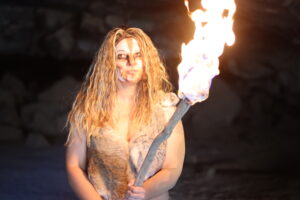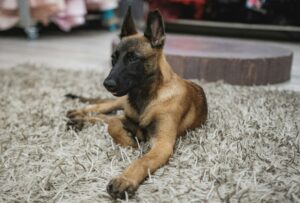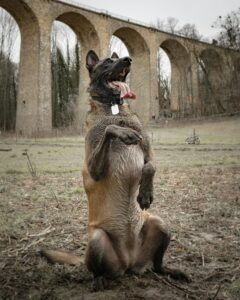Menu
Belgian Malinois Origin and Why You Shouldn’t Own One
The Belgian Malinois is a powerful working dog breed coming from Belgium. While they are fascinating and beautiful, they will not be the best choice for a family pet dog. I’ll be going over the history of the Belgian Malinois origin. In addition, this blog will outline several reasons why the average dog owner does not want to own one.
Evolving From Grey Wolves
Pre-historic man most likely over a period of 15,000 years domesticated grey wolves into dogs. As these wolves hung around humans more often, humans most likely engaged in some captive breeding. They most likely found some pups to raise and domesticate themselves and that would mark the obvious switch from wolf to domesticated dog.
Fast forward, and these dogs most likely helped the hunters in their hunts by herding for the tribes. A joint effort would yield better results for everyone. One can only imagine that prehistoric hunting with newly domesticated wolves was a natural transition for both species. In addition, dogs also guarded camps which provided a lot of security for humans against intruders.
Prehistoric Man Used Dogs for Hunting
Prehistoric humans transitioned from hunter gatherer tribes into the Neolithic Revolution (having our own herds and crops) which was a huge development for us. Although we cannot travel back in time to see exactly what happened, we can assume that dogs helped humans with herding livestock during this early period about 12,000 to 15,000 years ago. Yes that is a photo of me hanging out in a cave as a cavewomen – do cosplay sometimes.
Fast forward to Europe, where various dog breeds developed, shaped by diverse landscapes, human needs, and selective breeding practices. Among these were the herding dogs, tasked with protecting and guiding livestock across varied terrains. Interestingly, early herding dogs, believed to share ancestry with wolves and other Eurasier breeds, displayed traits like intelligence, trainability, and strong herding instincts.

The Birthplace of the Belgian Malinois: 19th Century Belgium
Belgian Malinois history and breed enthusiasts place its emergence in the late 19th century.
The region, with distinct sheep-rearing practices and varied terrains, nurtured the development of four distinct varieties under the umbrella of the Chien de Berger Belge (Belgian Shepherd Dog). These were the Groenendael (long-haired black), the Tervuren (long-haired fawn), the Laekenois (shorthaired fawn), and the Malinois (shorthaired fawn with a black mask).
I find it interesting that the Belgian Malinois origin, was named after the city of Malines in central Belgium. They were particularly prized for their agility, stamina, and keen herding instincts. These attributes proved invaluable for managing sheep herds on Belgium’s challenging terrain, characterized by harsh weather conditions and uneven landscapes.
While the exact breeds that contributed to the Belgian Malinois Origin remain debated, experts suggest ancestry linked to local herding dogs, Dutch Shepherds, and possibly German Shepherds.
Belgian Malinois History
The Belgian Malinois was known for its intelligence, trainability, and fearless nature which made it a natural fit for various working roles. During World War I and II, Malinois served as messenger dogs, scouts, and guard dogs, displaying exceptional courage and loyalty. This exposure from wartime captured the attention of the wider world.
Today, the Belgian Malinois is utilized by police forces, search and rescue teams and as active sport dogs in agility and Schutzhund. I recommend experienced owners who can provide ample physical and mental stimulation.

Why You Should Not Own a Belgian Malinois
I do not recommend them for the average dog owner and here is why.
High Intensity and Demand: Malinois possess high energy and require extensive physical and mental stimulation. They excel in demanding activities like dog sports, Schutzhund training, or working roles. I recommend anyone with a Malinois have enough time to train them properly and to keep them physically active. In addition, my blog on dog aggression may be helpful in this case.
Independent Spirit and Strong Drive: If you are looking for a cuddle buddy, the Malinois is not for you. Most people don’t realize that they were bred to be independent. Their strong herding instincts can manifest as unwanted behaviors like nipping or chasing small children or cats. They require experienced owners who can provide firm, consistent training and leadership.
Potential for Reactivity: Their sharp focus and alertness can translate into reactivity towards unfamiliar people, animals, or stimuli. Balanced dog training is crucial to manage their potential defensiveness and ensure they become balanced dogs.
Not Ideal for First-Time Dog Owners: I don’t recommend malinois for first-time dog owners or those without experience handling high-energy breeds. They thrive with owners who understand their working heritage, can provide proper training and structure with an active lifestyle.
Being a Responsible Dog Owner
Interested in learning what the difference is between a German Shepherd and a Belgian Malinois?
In conclusion, dog ownership is a big responsibility and choosing the right breed for your lifestyle is very important. Do not go with the trendy or beautiful dog that you cannot handle. Similarly, people get huskies because they like the way they look. However, they too are a powerful breed that require the proper training and exercise. Understanding the behavioral issues that can surface when the Belgian Mal is not with an experienced owner is imperative before anyone makes this decision.
If you have any further questions please reach out! I am a balanced dog trainer in Portland, Oregon and I also do remote dog training consultations with people from all over the world.

